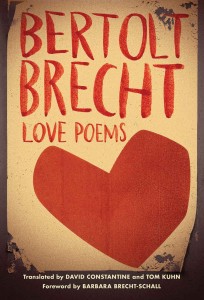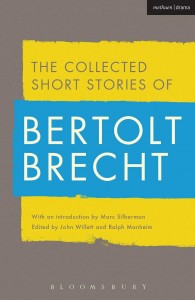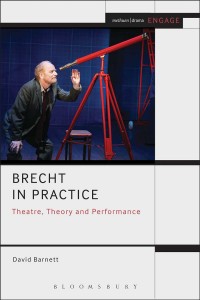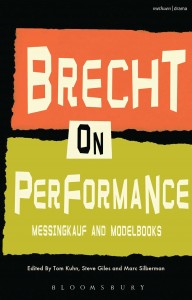Bertolt Brecht wore many hats: artistic director, theorist, prose writer, director, and poet. In America he is primarily known as a playwright, but Brecht scholar Eric Bentley has argued: “If there is a Brechtian quintessence, you will find it there: in the poetry.” There is no denying that Brecht’s poems—which number more than 2,000—have the same mesmeric power as do his plays; they also grappled with a timely, encompassing geopolitics and the barbarism of self-preservation.

In Bertolt Brecht: Love Poems, translators David Constantine and Tom Kuhn have curated 78 of Brecht’s love poems, covering the period from 1918 to 1955, just a year before his death. In her foreword to this volume, Barbara Brecht-Schall, Brecht’s daughter, affirms what many already know: “Papa loved women, many women.” Brecht’s amorous or libidinal appetite was complex, particularly for those women who were friends, associates, lovers, and collaborators simultaneously. With this complexity has come accusations that Brecht manipulated and often used women; he also idolized and hyper-romanticized them.
Constantine and Kuhn’s translations make these poems admirably accessible. They not only have an autobiographical fidelity; they also have the poetic justification of love working for them. The translators validate Brecht’s technical virtuosity: “He works effectively in hexameters, in tight rhyming quatrains, sonnets, ballads, unrhyming verse in regular meters, and in numerous other shapes and forms as the poetic occasion demands.” The technique matters less, of course, than the excitement generated by the poems. While none has the metaphoric force of Elizabeth Barrett Browning’s How Do I Love Thee?, say, or Carl Sandburg’s A Dream Girl, they do pack their own unique poetic punch. For example, Brecht’s Baal’s Song:
If I find a well-stacked woman, then I take her in the hay.
Lift her skirts and let the breeze in, in the sun—for that’s my way.
If she bites me in flagrante, then I wipe her down with hay.
Mouth and teeth and crotch, gallantly: nice and clean—for that’s my way.
If the wench gets in a fever of excitement at our play,
I salute and laugh and leave her, friendly—for that’s my way.
The charm of this particular poem is characteristic of numerous others in this volume. They register the sentiments of the female as well as of the male voices, while covering a wide path of love and its engagement with life, from the pain of a former teacher’s death to the drudgery of a sex worker’s employment. Brecht’s amatory experiences with Margarete Steffin, Ruth Berlau, Elisabeth Hauptmann, and Helene Weigel, his wife, clearly influence these poems, and the reader may wonder which ones, if any, are connected to Bie Banholzer, the young girl who bore Brecht his first son. Among other things, this collection ably makes the case that Brecht’s audience deserves to be wider than theatre enthusiasts.

Brecht’s cultural pursuits extended beyond poetry, of course—a point made by Marc Silberman in a new introduction to The Collected Short Stories of Bertolt Brecht (edited by John Willett and Ralph Manheim, and translated by Yvonne Kapp, Hugh Rorrison, and Anthony Tatlow). “While best known as a dramatist and poet, Bertolt Brecht was first and foremost a prose writer, more specifically a storyteller,” Silberman writes. Like his poetry, his short prose writing is not well known in America. Clearly this new edition of The Collected Short Stories aims to place Brecht in the select group of other well-established playwrights/poets—John Millington Synge, William Butler Yeats, Langston Hughes—who increased their creative stature via their prose writing.
The collection, first published in 1983, consists of 37 short stories that demonstrate Brecht’s talent as a prose stylist. They are separated into three distinct periods: The first (The Bavarian Stories, 1920-1924) explores autobiographical themes for a young man coming to understand lessons about male comradeship and marriage, struggling to make sense of the randomness of life, and searching for meaning in exotic parables. “I am neither a murdering rapist nor a matrimonial swindler. I am a lover,” says a character in “A Mean Bastard” who moves in with the lonely widow, Marie Pfaff, and proves to be a real bastard. It’s not all bleakness about human nature: In “The Foolish Wife,” after hardship, disappointment, and other trials, a husband and wife come to understand true love. Giving historical context for these early stories, Silberman points out that newspapers and journals of the time were more interested in them than in Brecht’s plays.
The second section (The Berlin Stories, 1924-1933) includes stories written before Hitler’s rise to power; these have a gritty, hard-hitting, realistic appeal. Silberman notes that the stories were “possibly motivated more by financial considerations than a commitment to the prose form as such.” Business, boxing, and bad behavior are the main thematic substance here. In a story that captures the desperate spirit of the times, “A Little Tale of Insurance” offers an incident in which the financier Kücklemann, on the brink of bankruptcy, manifests greed and inhumanity in his attempt at self-preservation.
It is in the last segment (Stories Written in Exile, 1933-1948) that Brecht puts forth stories in explicit resistance to fascism. “Socrates Wounded,” as engaging as it is to read, piqued my attention, as Brecht becomes a historical revisionist in retelling the tale of Socrates’ bravery during a war battle.
But whether Brecht is negotiating relationships, providing narrative attesting to a character’s humanity, or offering an anthropological approach to displacement or alienation, there is always a superior literary talent at work. His plots, characterizations, style, and language in these short stories prove Silberman’s point. Among other things, Brecht was a great and engaging storyteller. I’d even go so far as to say that many of the offerings in The Collected Short Stories of Bertolt Brecht are equal to his works for the stage.

Of course, many readers will approach Brecht’s prose writing and poems as byproducts of his theatre work. The latter is the focus of David Barnett’s Brecht in Practice: Theatre, Theory and Performance, which opens with the assertion that Brecht not only gained “an international reputation as a playwright, he also developed new ways of understanding theatre and new ways of making theatre as a director.” Unlike Constantine, Kuhn, and Silberman, Barnett frames Brecht firmly in the field of the theatre, focusing on him both as a theorist and as a practitioner. Barnett uses Brecht in Practice to argue that Brecht, despite his laudable and lasting reputation, is still very much misunderstood.
Barnett starts from the foundation that as a Brecht was a Marxist, and that his art was thus very much tied to his politics. Why, then, he wonders, is “politics…so frequently lacking from reference to the ‘Brechtian’”? He argues that what “defines Brecht’s contribution to theatremaking is his politicized method of approaching dramatic material.” In eight chapters, Barnett explores many aspects of Brecht’s practical and theoretical involvement in theatre; much of this material has been covered and is widely taught in educational institutions, from epic theatre to the alienation effect/Verfremdung to anti-allusive theatre, and so on. But Barnett brings a fresh perspective, as his ultimate goal is to convince the reader that Brecht “as theorist and practitioner is neither outdated nor irrelevant but waiting to be discovered.”

Barnett has done meticulous research and presents a very engaging scholarly argument. The same can be said for Brecht on Performance: Messingkauf and Modelbooks (edited by Tom Kuhn, Steve Giles and Marc Silberman; translations by Charlotte Ryland, Romy Fursland, Steve Giles, Tom Kuhn, and John Willett), which makes an excellent complement to Brecht in Practice. “Brecht is widely known (and unjustly feared) as a theorist of the theatre” is the opening to the introduction of Brecht on Performance. Not to worry: A team of Brechtian scholars, translators, and teacher/director Di Trevis (who has been working on Brecht’s material for more than 40 years) are here to convince you that Brecht should not be feared. Brecht on Performance, divided into two parts, is a collection of Brecht’s major writings for theatre practitioners. The editors refer to them as “Brecht’s most fragmentary works, or perhaps not a ‘work’ at all, but a compilation of deliberations about the practice of the theatre (and much else besides) which remained unpublished in his own lifetime.” These theoretical essays concern the practice of theatre (known as Messingkauf, or “buying brass”) and explore the way actors should interpret and perform a text.
The second part (Modelbooks) provides insights into Brecht’s rehearsal techniques in his productions of The Life of Galileo, Antigone, and Mother Courage and Her Children, as well as documentation and pictures of other plays. We have so much of the latter because Ruth Berlau was notorious for her picture-taking: During the production of Life of Galileo in Los Angeles, Eric Bentley reported, “The click of her camera had driven Charles Laughton to threaten to kill her with his bare hands if she didn’t stop.”
Apart from reading and experiencing the plays themselves, you won’t find a better perspective on Brecht’s multifaceted talent than in these four books, which cover all the major facets: You get a glimpse of a committed theoretician and artist pushing boundaries toward new discoveries; you get the man of theatre, the narrative prose stylist, and the poet. You couldn’t ask for more from an artist.
Nathaniel G. Nesmith is a C3 Postdoctoral Fellow in the Theatre Department at Middlebury College.


